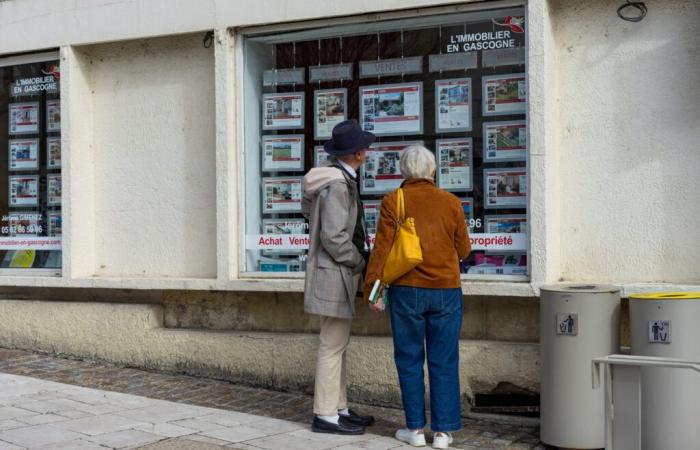Nearly 70% of Belgian households own their home.©Belga Image
Every region is affected by the decline in real estate purchasing power. But it is in Flanders that it is most marked (14.2% average decrease), ahead of Wallonia (12.4%) and Brussels (11.5%). In 2024, the price of Brussels houses decreased by 1.4%, with an average price of €555,667. However, one thing has not changed: it is in this region that the situation remains most critical. Concretely, in November, a household can afford on average 61 m² in Brussels, 105 m² in Flanders and 148 m² in Wallonia. The cause is a meteoric rise in interest rates which reach 4% compared to 2% at the start of 2023, combined with that of house prices. Compared to 2023, the average price of a house increased by 2.1% (€329,468) and that of an apartment by 1.5% (€268,709).
1 Belgian in 10 multi-owners
A temporary problem for some, who cite the war in Ukraine and the Covid crisis. In short, inflation hit, and the ECB (European Central Bank) responded with an increase in interest rates. Furthermore, the price of new housing has particularly suffered from the increase in the cost of construction materials. On the other hand, others believe that the problem is structural and point the finger at real estate speculation. According to them, housing is not a fundamental right, but a good like any other.
Whatever we think, our country has its share of multi-owners: 1 in 10 Belgians owns at least two properties. Their proportion even increased by 7% between 2022 and 2023.
Decline in purchasing power = decline in sales?
The correlation between rising prices and rising sales is clear. But the rate at which they are falling is decreasing. During the first three months of 2024, sales fell by 7.3% compared to the same period in 2023. During the first half of 2023, the drop in sales was 6.5% in Wallonia and by 0.8% in Brussels. During the first quarter of 2024, there were -3.9% sales in Wallonia and -1.4% in Brussels. In other words, sales are falling, but less quickly than before. But why?
We must first note the promise of a spectacular reduction in registration fees in Wallonia by 2025, i.e. 3.5% compared to 12.5% currently. But that’s not all: faced with the stabilization of inflation, the ECB (European Central Bank) reduced its key rates for the first time in June 2024, then in September.
A majority of owners
For a large majority of Belgians, this increase in prices is rather positive, since almost 70% of households own their home. But for some, becoming an owner is a utopia. Moreover, the average age of a first-time buyer is 34 years old, compared to 28 years old around fifteen years ago. Indeed, borrowing conditions have never been so strict (significant equity capital, permanent contracts), while the job market is increasingly precarious (advent of flexi-jobs, etc.).
Some wait for years, or even their entire lives, especially if they do not benefit from any family support. And sometimes in deplorable conditions. Indeed, compared to owners, tenants are much more subject to problems of dilapidation (which can cause serious lung problems) and overcrowding. However, this phenomenon is also the mirror of the evolution of our society, as underlines Renaud Grégoire, notary. “More and more young people immediately want a property on Place Brugman or in Châtelain with a PEB B. But that’s not all: they especially don’t want to do renovations or take care of maintenance. And if possible, be the only buyer So, unless you have enormous equity, it’s impossible.”
Who is buying in 2024?
In 2022 and 2023, the share of buyers aged 30 or under decreased by almost 3%. Little by little, it seems that they are ready to buy again. In 2023, they represented 29.3%, compared to 27.1% for the first three months of 2024 alone. But overall, the real estate market remains a matter of forty-year-olds, the average age of the Belgian buyer this year being 39 years, with very slight variations depending on the region.
Ever-bigger new houses
And the criteria have also changed, as Alexandre Verdonck, real estate analyst, notes: “Now, a good PEB is a main criterion whereas it was not even considered five years ago. Buyers are, on the other hand, more cautious when purchasing a property to be renovated, and the size of the property is less important than before. Moreover, we are building smaller homes than 30 years ago, but it will still take years before this really has an impact on rental supply. Brussels, for example, housing built after 2000 represents less than 5% of the total!”
Indeed, more and more players in the sector are calling for the construction of smaller, more sustainable housing. But this is clearly not a priority for large wallets. In Wallonia, the median surface area of new houses has increased by 7 m² over the last five years, and by 11 m² in Flanders. Brussels is an exception, with a decrease of 41 m².






